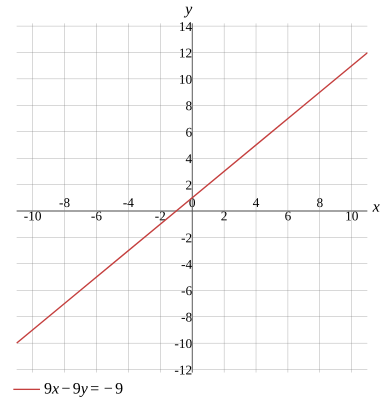Question
Function
Find the x-intercept/zero
Find the y-intercept
Find the slope
x=−1
Evaluate
9x−9y=−9
To find the x-intercept,set y=0
9x−9×0=−9
Any expression multiplied by 0 equals 0
9x−0=−9
Removing 0 doesn't change the value,so remove it from the expression
9x=−9
Divide both sides
99x=9−9
Divide the numbers
x=9−9
Solution
More Steps


Evaluate
9−9
Reduce the numbers
1−1
Calculate
−1
x=−1
Show Solution

Solve the equation
Solve for x
Solve for y
x=−1+y
Evaluate
9x−9y=−9
Move the expression to the right-hand side and change its sign
9x=−9+9y
Divide both sides
99x=9−9+9y
Divide the numbers
x=9−9+9y
Solution
More Steps


Evaluate
9−9+9y
Rewrite the expression
99(−1+y)
Reduce the fraction
−1+y
x=−1+y
Show Solution

Testing for symmetry
Testing for symmetry about the origin
Testing for symmetry about the x-axis
Testing for symmetry about the y-axis
Not symmetry with respect to the origin
Evaluate
9x−9y=−9
To test if the graph of 9x−9y=−9 is symmetry with respect to the origin,substitute -x for x and -y for y
9(−x)−9(−y)=−9
Evaluate
More Steps


Evaluate
9(−x)−9(−y)
Multiply the numbers
−9x−9(−y)
Multiply the numbers
−9x−(−9y)
Rewrite the expression
−9x+9y
−9x+9y=−9
Solution
Not symmetry with respect to the origin
Show Solution

Rewrite the equation
Rewrite in polar form
Rewrite in standard form
Rewrite in slope-intercept form
r=−cos(θ)−sin(θ)1
Evaluate
9x−9y=−9
To convert the equation to polar coordinates,substitute x for rcos(θ) and y for rsin(θ)
9cos(θ)×r−9sin(θ)×r=−9
Factor the expression
(9cos(θ)−9sin(θ))r=−9
Solution
r=−cos(θ)−sin(θ)1
Show Solution

Find the first derivative
Find the derivative with respect to x
Find the derivative with respect to y
dxdy=1
Calculate
9x−9y=−9
Take the derivative of both sides
dxd(9x−9y)=dxd(−9)
Calculate the derivative
More Steps


Evaluate
dxd(9x−9y)
Use differentiation rules
dxd(9x)+dxd(−9y)
Evaluate the derivative
More Steps


Evaluate
dxd(9x)
Use differentiation rule dxd(cf(x))=c×dxd(f(x))
9×dxd(x)
Use dxdxn=nxn−1 to find derivative
9×1
Any expression multiplied by 1 remains the same
9
9+dxd(−9y)
Evaluate the derivative
More Steps


Evaluate
dxd(−9y)
Use differentiation rules
dyd(−9y)×dxdy
Evaluate the derivative
−9dxdy
9−9dxdy
9−9dxdy=dxd(−9)
Calculate the derivative
9−9dxdy=0
Move the constant to the right-hand side and change its sign
−9dxdy=0−9
Removing 0 doesn't change the value,so remove it from the expression
−9dxdy=−9
Change the signs on both sides of the equation
9dxdy=9
Divide both sides
99dxdy=99
Divide the numbers
dxdy=99
Solution
More Steps


Evaluate
99
Reduce the numbers
11
Calculate
1
dxdy=1
Show Solution

Find the second derivative
Find the second derivative with respect to x
Find the second derivative with respect to y
dx2d2y=0
Calculate
9x−9y=−9
Take the derivative of both sides
dxd(9x−9y)=dxd(−9)
Calculate the derivative
More Steps


Evaluate
dxd(9x−9y)
Use differentiation rules
dxd(9x)+dxd(−9y)
Evaluate the derivative
More Steps


Evaluate
dxd(9x)
Use differentiation rule dxd(cf(x))=c×dxd(f(x))
9×dxd(x)
Use dxdxn=nxn−1 to find derivative
9×1
Any expression multiplied by 1 remains the same
9
9+dxd(−9y)
Evaluate the derivative
More Steps


Evaluate
dxd(−9y)
Use differentiation rules
dyd(−9y)×dxdy
Evaluate the derivative
−9dxdy
9−9dxdy
9−9dxdy=dxd(−9)
Calculate the derivative
9−9dxdy=0
Move the constant to the right-hand side and change its sign
−9dxdy=0−9
Removing 0 doesn't change the value,so remove it from the expression
−9dxdy=−9
Change the signs on both sides of the equation
9dxdy=9
Divide both sides
99dxdy=99
Divide the numbers
dxdy=99
Divide the numbers
More Steps


Evaluate
99
Reduce the numbers
11
Calculate
1
dxdy=1
Take the derivative of both sides
dxd(dxdy)=dxd(1)
Calculate the derivative
dx2d2y=dxd(1)
Solution
dx2d2y=0
Show Solution

Graph
